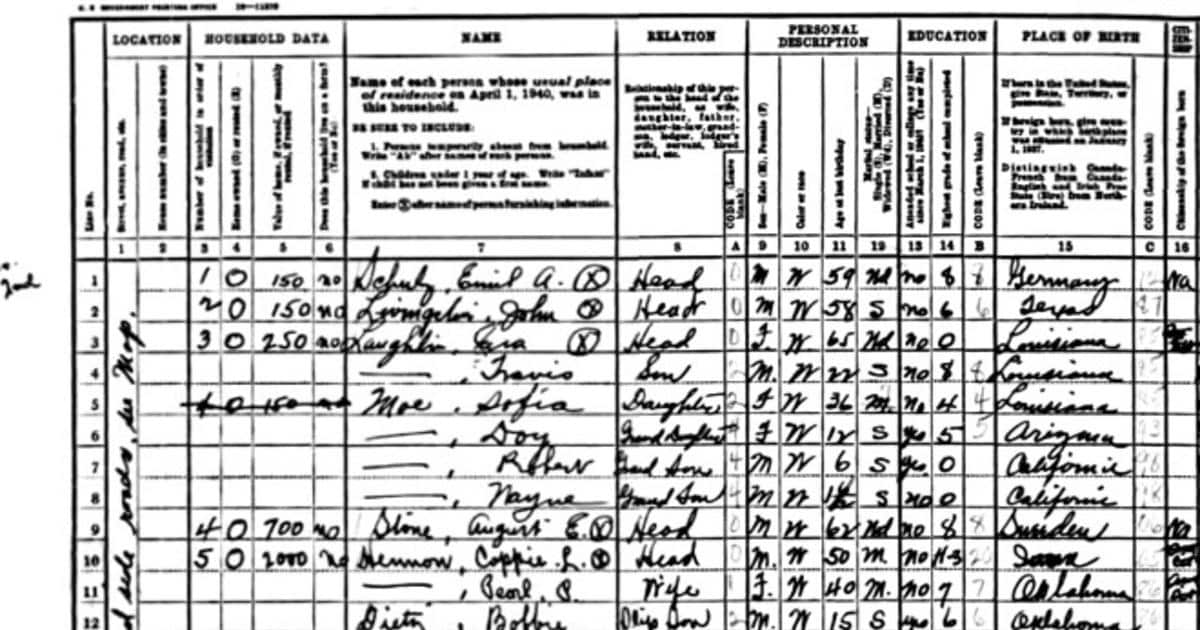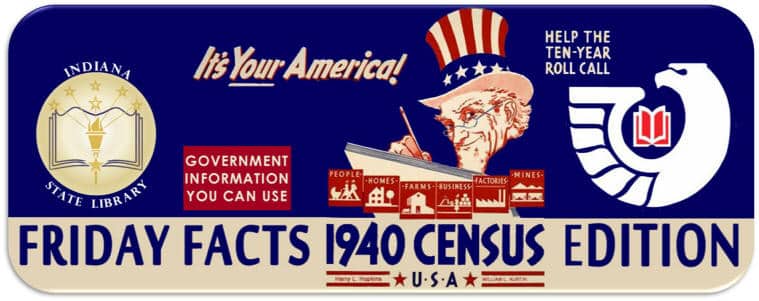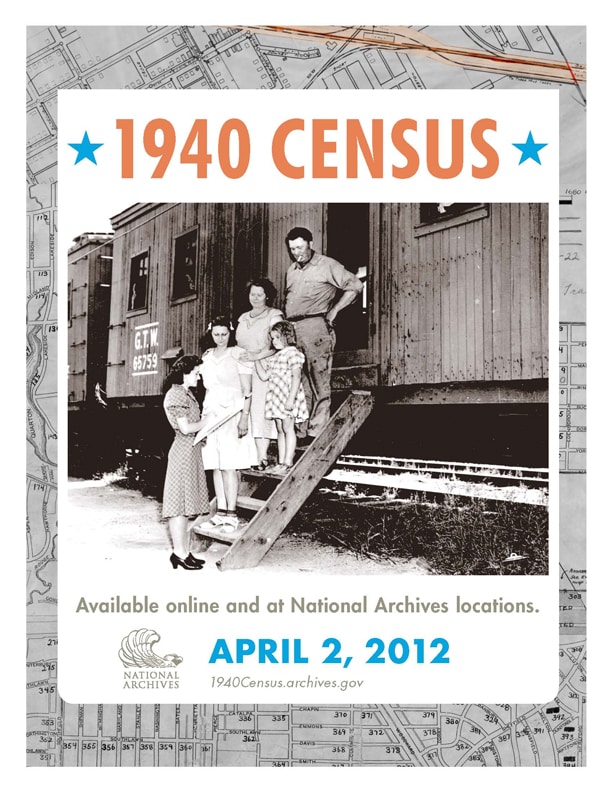
Knowing one’s family history is important for many reasons. Some wish to validate family stories or determine if they are related to a famous person. Searching for our past is often a part of natural human curiosity. Organizations such as the Daughters of the American Revolution are dedicated to not only knowing one’s lineage, but learning more about an ancestor’s part in a specific event in history. Then, there are those searching for a birth parent who take to ancestral research.
No matter one’s motivation for getting involved in the study of family genealogy, today, there are a number of resources available for carrying out this type of research. One of these resources is the 1940 U.S. Census Community Project.
History of the 1940 U.S. Census Community Project
At least eighty-seven percent of Americans today can find at least one relative listed on the 1940 United States Federal Census. The federal government has taken a census of the population every ten years since 1790. The 1940 Census is currently the largest census released to date; it is also the most recent census available for public access.
The 1940 Census, taken on April 1, 1940, was the sixteenth census conducted since 1790. The population of the United States at that time totaled 131,669,275 within the continental United States. This number represented a population increase of 7.2 percent since the 1930 census. The 1940 Census also added the populations of Hawaii, Puerto Rico, Guam, the U.S. Virgin Islands, Alaska, American Samoa, and the Panama Canal Zone. The total population considering all these additions was 134,176, 298.
Census taking in 1940 was much different than the last census the United States’ most current census in 2020. Census planners split the country into enumeration districts; an “enumerator” (census taker) would visit every house inside a district within the time span of two weeks (in the city). For enumerators based in more rural areas, one month was allowed to complete their tallies. Census takers were directed to “visit every house, building, tent, cabin, hut or other place in which any person might live or stay, to insure that no person is omitted from the enumeration.” The enumeration would begin on 12:01 A.M. on April 1, 1940 in order to count “each person alive at the beginning of the census day.”
The census takers used certain shorthand to count members who were a part of each household but absent at the time the enumerator came by to count each person. The 1940 Census also counted visitors in each household, which is an anomaly compared with the way census information is recorded today. In fact, students were to be counted, as were patients in hospitals and sanitariums. Servants and household employees that did not live on the premises were also counted.
Enumerators also counted people residing in “hotels, tourist or trailer camps, missions, and cheap one-night lodging houses (also known as ‘flophouses.'” Census takers employed to carry out the 1940 census worked all of April 1940 and into May to complete the taking of data.
On April 2, 2012, the United States National Archives released the 1940 census records. Archives.com assisted in bringing the data online. Over 160,000 volunteers came together to get the 1940 Census data completely indexed; this effort allowed the entire census to be searched online. Within four months, over 132 million names were indexed so that the index would be high quality and provide a wealth of information for those searching for information.
On July 2, 2012 volunteers with the 1940 Census Community Project indexed 10,000 names, which broke and actually doubled the previous record of 5 million names indexed.

What were the Census Questions in 1940?
The enumerators were tasked with asking multiple questions in addition to counting the number of people living in each household. Each census taker was equipped with fifteen questions that they must find answers; they also had supplemental questions that were only offered to a random five percent of the population.
Each census taker was required to find answers to the following questions:
- What is your address?
- What is the value of your current home, and do the occupants own or rent the property?
- What is the name of each person whose usual place of residence on April 1, 1940 would be a part of the household? (This is why people in hospitals as well as students were counted.)
- What is each person’s relationship to the head of the household?
- What is the gender of each person in the household?
- What is the racial make-up of each household? (One may have seen the term “color” used in the questions.)
- What is each person’s age at his or her last birthday?
- What is the marital status of each person in the household?
- What is the education level of each person in the household?
- What is the place of birth of each person in the household?
- What is the citizenship of each member of the household?
- What is each person’s residence as of April 1, 1940?
- For people ages 14 and over, the enumerator was to find each resident’s employment status.
- There were several questions regarding said employment.
- What is your occupation and number of weeks worked full-time in 1939?
- What was your income in 1939?
In addition to these standard questions, each enumerator randomly selected a group of individuals to ask the following questions.
- What is the birthplace of your mother and father?
- What is your native language?
- What is your veteran status? (This question was also offered to widows and minor children of veterans.)
- What are your Social Security details?
- What is your occupation, industry, and class as a worker?
- For women, the enumerator asked details about marriage. These details included whether or not a woman was married more than once, her age at her first marriage, and the number of children she had.
Some interesting details could be gleaned from the census data. Keep in mind that the census was taken at a time when immigrants had come to America only recently (many counted in the census had parents who were immigrants) and the Great Depression was still in effect as well.
1. The top five foreign countries where many of these first-generation Americans hailed from (listed as birthplace) were England, Russian, Italy, Germany, and Poland.
2. The most commonly listed birth state is New York.
3. The average household size recorded during the enumeration of 1940 was 3.7 people.
4. The oldest women counted as a part of the census were both 119. The women were Mary Dilworth of Oxford, MS and Candido Vega Y Torres of Guayama, Puerto Rico.
5. The most common given names listed on the 1940 Census were John and Mary.
6. The top five most common surnames listed on the 1940 Census were Jones, Smith, Brown, Johnson, and Williams.
7. Over 850,000 people stated that they lived in hotels or a similar type of housing.
Free 1940 Census Search By Name Resources
Anyone can go online and search the 1940 Census records via 1940census.archives.gov. They may also go to Population Schedules for the 1940 Census.
The NARA or National Archives and Records Administration offers public access computers at any NARA research facility.
One may also utilize the familysearch.org website to find information regarding the 1940 census. The website offers a direct link to the 1940 census, and the site is user-friendly.
One may also go to the genealogy records at the www.census.gov website.
Most of these sites offer a variety of ways to search for one’s ancestors listed on the 1940 website. Individuals may even be able to enter a street address to begin a search.
Ancestry
One may also access free 1940 census data at the Ancestry.com website. This informational site allows for an individual to simply enter a name into the database to conduct a search. One will need to register for a free Ancestry.com account. There are how-to videos at the Ancestry site that can show users how to navigate the information available on the 1940 census. Plus, the Ancestry.com website offers some neat facts about the home values, chief occupations, and most popular names gathered in the 1940 census.
FamilySearch
Familysearch.org offers not only a great deal of information, but the site offers “how-to” tips if searchers have difficulty finding a relative. One can search under the ancestor’s given name or alternative names (pertinent for a grandmother who may have married after the census). One can also search for an individual using information such as the relative’s residence (particularly the person’s residence in 1940) as well as marriage, death, and birth records. Finally, one can use relationships to search for ancestors – spouse, parents, and other relationships.
Helpful Census Search Tips
It’s always best to start with multiple bits of information on your ancestor (for instance, your grandfather’s name PLUS his birthplace is more likely to garner more information than simply entering a common name such as John Smith). It’s always a good idea to search abbreviations of given names as well. One can add keywords and additional family members’ names as well if available. Finally, utilizing a filter for your results will also save time and likely point you in the direction of more pertinent information.

Frequently Asked Questions:
Is the 1940 federal census public?
Yes, the information gathered on the census is public and free to users.
How do I find someone in the 1940 census?
All one needs is a name get started. However, individuals can also search by a street address or by birthplace. There are multiple ways to find one’s ancestors using the free people search websites available.
Can you view old census records for free?
No. Some sites require one to be a member of the site in order to access records. However, if the NARA or National Archives have released the census data, one should be able to retrieve free census data on the National Archives website.





